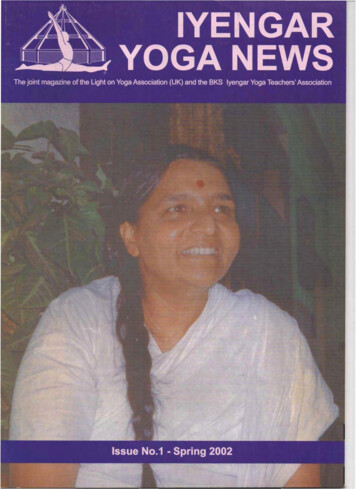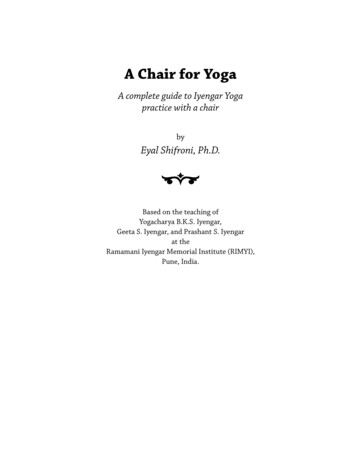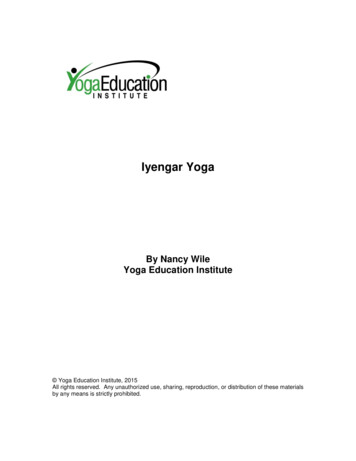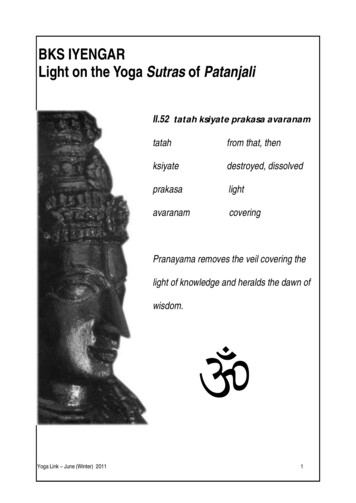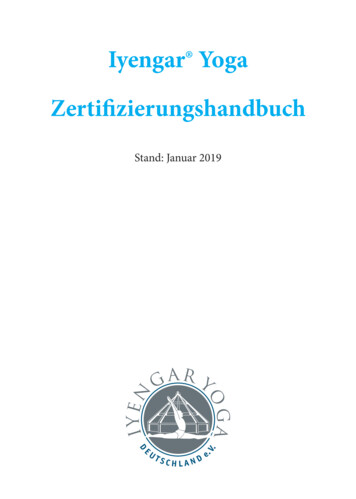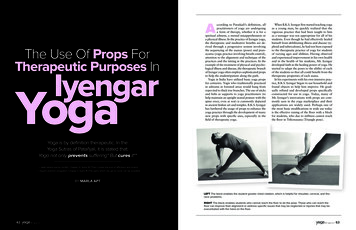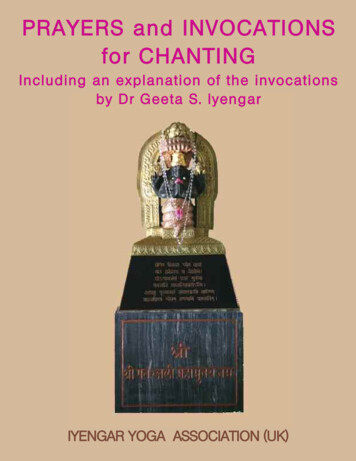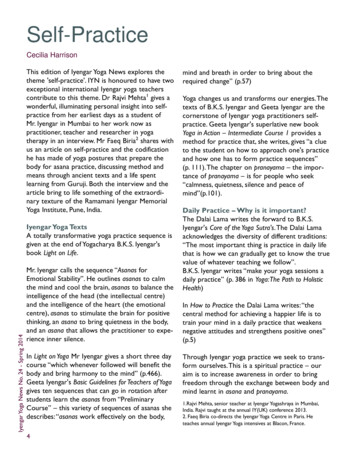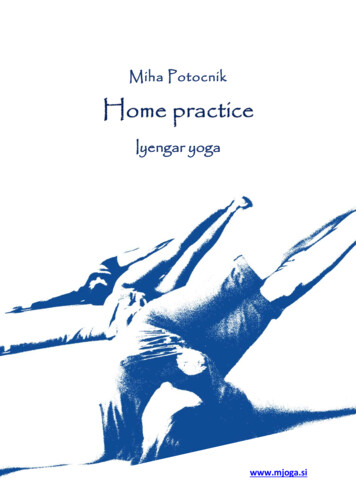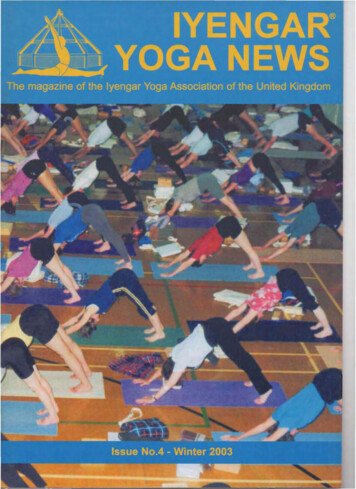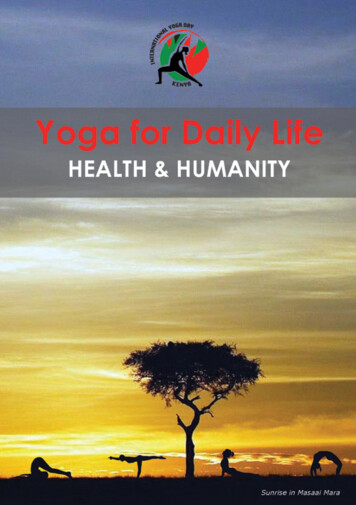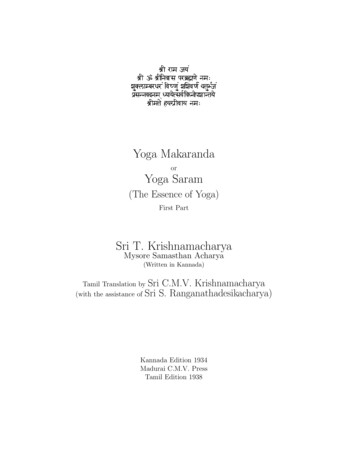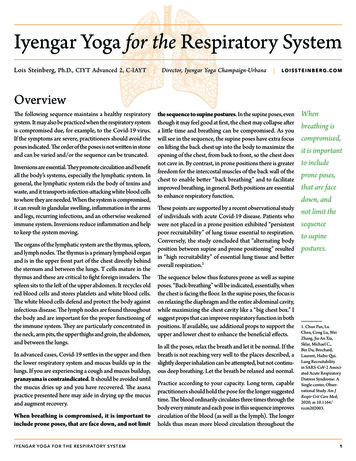
Transcription
Iyengar Yoga for the Respiratory SystemLois Steinberg, Ph.D., CIYT Advanced 2, C-IAYT Director, Iyengar Yoga Champaign-Urbana LOISSTEINBERG.COMOverviewThe following sequence maintains a healthy respiratorysystem. It may also be practiced when the respiratory systemis compromised due, for example, to the Covid-19 virus.If the symptoms are severe, practitioners should avoid theposes indicated. The order of the poses is not written in stoneand can be varied and/or the sequence can be truncated.Inversions are essential. They promote circulation and benefitall the body’s systems, especially the lymphatic system. Ingeneral, the lymphatic system rids the body of toxins andwaste, and it transports infection-attacking white blood cellsto where they are needed. When the system is compromised,it can result in glandular swelling, inflammation in the armsand legs, recurring infections, and an otherwise weakenedimmune system. Inversions reduce inflammation and helpto keep the system moving.The organs of the lymphatic system are the thymus, spleen,and lymph nodes. The thymus is a primary lymphoid organand is in the upper front part of the chest directly behindthe sternum and between the lungs. T cells mature in thethymus and these are critical to fight foreign invaders. Thespleen sits to the left of the upper abdomen. It recycles oldred blood cells and stores platelets and white blood cells.The white blood cells defend and protect the body againstinfectious disease. The lymph nodes are found throughoutthe body and are important for the proper functioning ofthe immune system. They are particularly concentrated inthe neck, arm pits, the upper thighs and groin, the abdomen,and between the lungs.In advanced cases, Covid-19 settles in the upper and thenthe lower respiratory system and mucus builds up in thelungs. If you are experiencing a cough and mucus buildup,pranayama is contraindicated. It should be avoided untilthe mucus dries up and you have recovered. The asanapractice presented here may aide in drying up the mucusand augment recovery.When breathing is compromised, it is important toinclude prone poses, that are face down, and not limitI Y E N G A R YO G A F O R T H E R E S P I R ATO R Y S Y S T E Mthe sequence to supine postures. In the supine poses, eventhough it may feel good at first, the chest may collapse aftera little time and breathing can be compromised. As youwill see in the sequence, the supine poses have extra focuson lifting the back chest up into the body to maximize theopening of the chest, from back to front, so the chest doesnot cave in. By contrast, in prone positions there is greaterfreedom for the intercostal muscles of the back wall of thechest to enable better “back breathing” and to facilitateimproved breathing, in general. Both positions are essentialto enhance respiratory function.These points are supported by a recent observational studyof individuals with acute Covid-19 disease. Patients whowere not placed in a prone position exhibited “persistentpoor recruitability” of lung tissue essential to respiration.Conversely, the study concluded that “alternating bodyposition between supine and prone positioning” resultedin “high recruitability” of essential lung tissue and betteroverall respiration.1The sequence below thus features prone as well as supineposes. “Back-breathing” will be indicated, essentially, whenthe chest is facing the floor. In the supine poses, the focus ison relaxing the diaphragm and the entire abdominal cavity,while maximizing the chest cavity like a “big chest box.” Isuggest props that can improve respiratory function in bothpositions. If available, use additional props to support theupper and lower chest to enhance the beneficial effects.In all the poses, relax the breath and let it be normal. If thebreath is not reaching very well to the places described, aslightly deeper inhalation can be attempted, but not continuous deep breathing. Let the breath be relaxed and normal.Practice according to your capacity. Long term, capablepractitioners should hold the pose for the longer suggestedtime. The blood ordinarily circulates three times through thebody every minute and each pose in this sequence improvescirculation of the blood (as well as the lymph). The longerholds thus mean more blood circulation throughout theWhenbreathing iscompromised,it is importantto includeprone poses,that are facedown, andnot limit thesequenceto supinepostures.1. Chun Pan, LuChen, Cong Lu, WeiZhang, Jia-An Xia,Sklar, Michael C.,Bin Du, Brochard,Laurent, Haibo Qui.Lung Recruitabilityin SARS-CoV-2 Associated Acute RespiratoryDistress Syndrome: ASingle-center, Observational Study. Am JRespir Crit Care Med;2020; as 10.1164/rccm202003.1
body and more improvement in the health and vitality ofall the systems of the body.Please referto my booksfor knee, lowback, neckand shoulderproblemswhen theposes beloware notattainable asshown andalternativeset ups areneeded.In times of stress, the sympathetic system is dominant, andthe “flight or fight” response is triggered. If stress is chronic,the circulatory, lymphatic, respiratory, and other bodilysystems become imbalanced, are weakened, and health iscompromised. With yoga practice, the parasympatheticsystem, the relaxation response, becomes dominant. Thisis the gateway to health. This sequence helps promote thedominance of the parasympathetic system.Please refer to my books for knee, low back, neck and shoulder problems when the poses below are not attainable asshown and alternative set ups are needed. Also refer to mybook, Geeta S. Iyengar’s Guide to a Woman’s Yoga Practicefor Samaashrayi and Upaashrayi seated poses (also knownas L-Shapes, pp 70–75). These poses are good for fever,especially when done forward, upright, and then back,in succession. Practice the menstrual and post-menstrualsequences in Geeta’s Guide; these sequences are also goodfor stress reduction and building the immune system. Theforward bends in these sequences should be practiced withthe head and torso elevated for the respiratory system. MyIyengar Yoga Cancer Book also has many L-shape variations(pp. 24–29) and variations of supine poses to practice whenunwell. These books also include more detailed explanations of these poses.Herewith is the practice for the respiratory system andbeyond.1 Adho Mukha Virasana DownwardFacing Hero’s PoseSupport the buttocks and head with a folded blanket andthe torso with a bolster. Rest the forehead on the forearmsor hands (FIGURE 1). Widen and spread the collar bonesand sternum. Relax the abdomen. Allow the brain to restFIGURE 1I Y E N G A R YO G A F O R T H E R E S P I R ATO R Y S Y S T E Mtowards the forehead. Soften the mouth cavity. Observethe breath in the back chest. On the normal exhalations,release the intercostal muscles from the back to the frontbody and continue to breathe in and out of the back chest.Hold three to ten minutes.This pose is very quieting to the mind and body and is agood starting point for practice. Observing the breath inthe back is very easy in this position. This position maybe contraindicated for those with knee pain. Use the sameset-up for the next pose.2 Parsva Adho Mukha Virasana SideDownward Facing Hero’s PosePlace the bolster in front of or slightly on top of the rightknee. Re-fold the blanket into a three-fold to support theforehead so it does not restrict the arms. Bend over theright leg with the torso centered on the thigh. Reach thehands to hold the end of the bolster and extend the armsand sides of the torso evenly. Slightly step the left knee tothe left to further open the groin and soften the abdomenon that side (FIGURE 2). Observe the breath and despitethe asymmetry of the pose, evenly breathe in and out ofboth sides of the back. Additionally, lateral breathing willbe less on one side. Bring the breath to the side walls of thechest equally.Hold for three to five minutes, then bring the left kneeback in, and repeat bending over on the left side, steppingthe right knee slightly to the right. Return to the center toprepare for the next pose.By doing this pose on one side and then the other, thepractitioner stretches both kidneys, the liver, and the spleen.The actions also open and stretch the armpits and createspace for the lymphatic nodes in the armpits.FIGURE 22
3 Parivrtta Adho Mukha Virasana Revolved Downward Facing Hero’s PoseRemove the bolster from the previous pose. Reach the leftarm perpendicular to the torso. Press the right hand on thefloor near the right knee to lift the right shoulder up andrelease the left side of the back down. Align the ears parallelto the floor on a block (FIGURE 3).Hold one to threeminutes; then repeaton the other side.This pose “squeezes”then “soaks” the spleen,kidneys, and liver. Italso increases the flexibility of the intercostal muscles to facilitatebetter breathing.FIGURE 3FIGURE 4A4 Adho Mukha Svanasana DownwardFacing Dog PoseStand at a rope wall. Have a chair nearby to transition fromthis pose to the next. Place the lower rope over the head anddown to the top of the thighs. Step forward until the ropeis taut. Bend over and reach the arms forward and step theheels back to the wall. Extend the heels back and down onthe wall to touch the floor or as close to the floor as possible.Support the head on one or more blocks. Have just theforehead on the block so the eyes and nose are clear of thesupport. Reach the armpits forward and the inner top thighsback—to stimulate the lymphatic nodes that congregate inthese areas. Extend the arms straight, lock the elbows; extendthe legs straight, lock the knees. The complete extensionof the arms and legs lengthens the upper and lower spinalcolumn and elongates the abdomen, thus stimulating thelymph nodes in the abdomen. Continue to extend the legsback and arms forward. The ribs of the front body shouldnot push beyond the skin. The skin of the back body shouldgo slightly away from the ribs. This will expand and stretchthe chest and lungs.FIGURE 4B5 Ardha Uttanasana Half IntenseStretch PoseFrom the previous pose, step the feet forward until the legsare perpendicular to the floor. Fold the arms to BaddhaHastasana on the seat of the chair and rest the foreheadon the forearms. Relax the back of the head/brain towardsthe forehead. Straighten the knees completely to firm thethighs. The more the thighs are tightened, the more anystrain on the hamstrings is diminished (FIGURE 5A). Ifthe hamstrings and hips are very tight, remove the rope andStay in this pose one to five minutes (FIGURES 4A & 4B).Use the rope for the next pose.This pose is an inversion, as well as a back extension, anda forward extension. It is an activating, yet calming, pose.The chest expands and creates an optimal environmentfor the breath.FIGURE 5AI Y E N G A R YO G A F O R T H E R E S P I R ATO R Y S Y S T E M3
The torso support is soothing on thekidneys and encourages back bodybreathing. The eyes get soft and tensionis reduced. Supporting the front bodymakes you feel secure and calm.FIGURE 5Bplace the buttocks against the wall with the feet one to twofeet away from the wall. Go slightly wider with the feet andturn the toes further inward. Add one to two bolsters to theseat of the chair (FIGURE 5B). Bring the normal breath tothe back body/lungs.Hold for one to five minutes.This pose lengthens the spine to help balance the centralnervous system and quiet the mind.To further quiet the mind, repeat thepose with the hands and head down(FIGURE 6B) and/or hold the ankles( FIGURE 6C ). Position the headfurther back towards the heels andmore towards the back part of the topof the head. Let the back of the head,the occiput, release towards the floor.Allow the diaphragm to move towardsthe back.Hold for one to three minutes.When the back part of the top of thehead is on the floor and the occiputis released down in this variation, itfosters a “cooling effect” on the centralnervous system, the brain, and the eyes.The body and the mind become quiet.6 Prasarita Padottanasana Spread FootIntense Stretch PoseIf suffering severe viral symptoms,go to Prone Savasana (see Figure 21)to finish the practice.Position two chairs on a sticky mat with the seats facingeach other and one to three bolsters (depending on thebody size) horizontally stacked on top of the seats. Place theabdomen on the bolster and step the legs wider apart untilthe sacrum is spread. Place the hands on blocks and gazeforward with the eyes parallel to the floor (FIGURE 6A).7 Adho Mukha Vrksasana Downward Facing TreePoseHold one to five minutes.FIGURE 6BFIGURE 6CExtend the arms and legs as straightas possible. Release the head and neck(FIGURE 7).Hold this pose 20 seconds to oneminute.Going topsy turvy is important whenthe world is upside down. This pose isinvigorating and can relieve anxiety anddepression. The chest is fully expanded.Include this pose to maintain health. Italso builds up the muscular system—when unwell, avoid.FIGURE 6AI Y E N G A R YO G A F O R T H E R E S P I R ATO R Y S Y S T E MGoing topsy turvy isimportant when theworld is upside down.FIGURE 74
8 SalambaSirsasana I SupportedHeadBalancePoseAgain, emotionally, when yourworld has beenturned upsidedown, and yougo upside down,it can turn yourworld right sideup.FIGURE8BFIGURE 8CFIGURE 8DFIGURE 8EIf feeling well,practice this posefor three minutes,and if comfortable, for up to tenminutes to keepFIGURE 8Athe systems strong(FIGURE 8A). Come down before discomfort arises.If the head and neck are not able to sustain the classic posecomfortably, use two chairs to support the shoulders. Positionthe chairs on a sticky mat horizontal to the wall with the seatsof the chairs facing each other. Place sticky mats and foldedblankets on the seats. The chair seats should be as close aspossible for the shoulders to be supported up to the neck.The neck has to “slip in” from the front of the chairs. Go upone leg at a time. The legs can be apart to spread the pelvisand
IYENGAR YOGA FOR THE RESPIRATORY SYSTEM 1 Overview The following sequence maintains a healthy respiratory . system. It may also be practiced when the respiratory system is compromised due, for example, to the Covid-19 virus. If the symptoms are severe, practitioners should avoid the poses indicated. The order of the poses is not written in stone and can be varied and/or the sequence can be .
